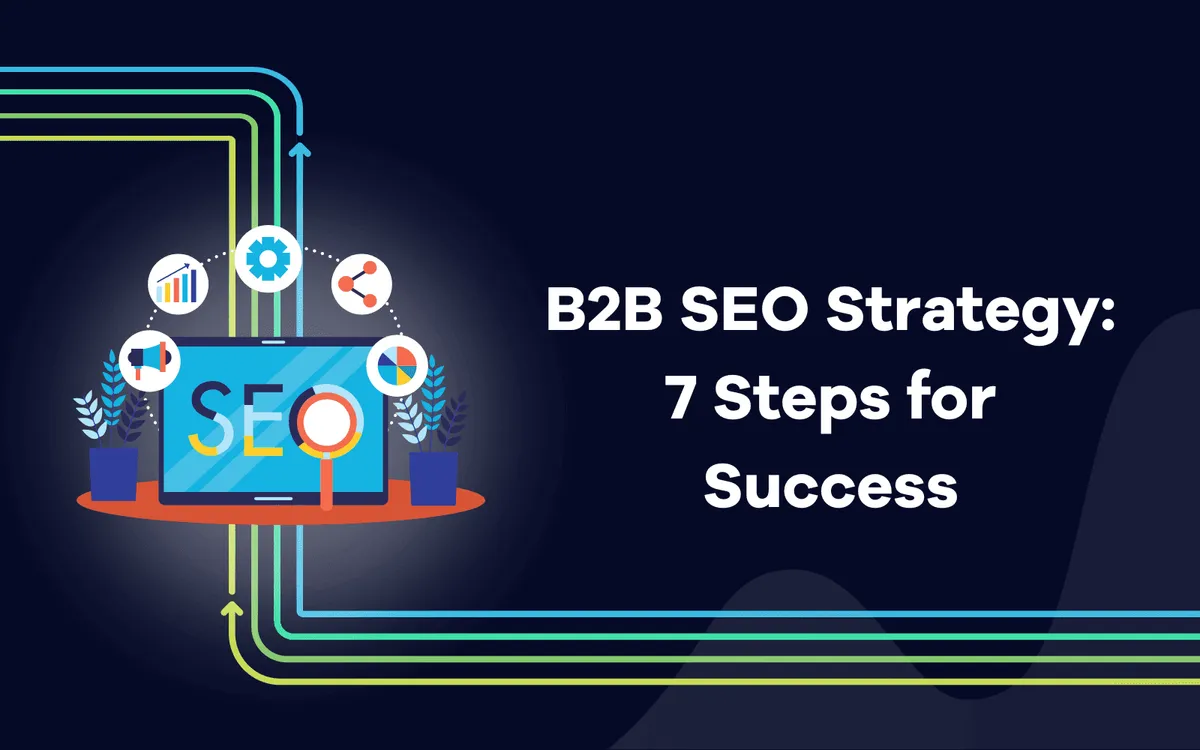
B2B SEO Strategy: 7 Steps for Success

David
September 3, 2023
Unlock B2B SEO success with our 7-step strategy. Drive traffic, leads, and growth for your business. Discover the power of SEO today!

A successful B2B SEO strategy increases your search visibility, boosts organic traffic, and increases sales.
And you’re on the best page to learn how to build such a plan.
This guide shows you:
- Essential differences between B2B and B2C SEO
- A 7-step plan with actionable tactics and examples
- Tools you can use
- Insider tips few people know
Keep reading below.
What Makes a B2B SEO Strategy Different From B2C?
B2B SEO implies optimizing your B2B website for search engines.
That means making it better so that:
- Search engines like Google understand what it is about, so they can index it better and rank it accordingly.
- Your B2B prospects find your website and navigate it easily.
- Influential creators, bloggers, and news outlets in your niche can find your content assets faster.
The first two points are essential for B2C SEO, but the last one is highly specific for B2B companies. SEO strategy depends on multiple factors. Therefore many businesses opt for managed SEO services from reputed SEO agencies.
Remember: The main goal of search engine optimization is to help you stand out from your competition. Creating linkable assets for potential link partners is an important part of B2B SEO.
More on that in a minute.
Let’s now analyze a few other differences between B2B and B2C, which will dictate your SEO strategy.
- B2B SEO aims to generate qualified leads and lasting relationships with loyal customers: By contrast, B2C SEO is geared at driving sales through traffic generation.
- B2B SEO focuses on building thought leadership: B2B sales cycles are longer, so creating content for the top of the sales funnel is essential.
- B2B SEO needs tactical content: B2B prospects do more in-depth research because they are company decision-makers. That means they need more informative and strategic content at all funnel stages.
The 7-Step Plan for a Successful B2B SEO Strategy
After running through the particularities of a successful B2B SEO strategy, let’s see how you can build one.
1. Research
Search engine optimization should be data-driven. That’s key to creating an effective long-term strategy that sets you apart from the competition.
According to the internal guidelines of our B2B SEO agency, the research typically encompasses three aspects:
- Your website
- Your audience
- Competitors (keyword opportunities, valuable content assets, and potential link partners)
We’ll review these below.
1.1. Your Website
Researching your website aims to identify the following:
- Technical SEO issues
- Current keyword and content strategy
- Internal linking
- Backlink profile
SEO tools reveal your website’s strengths and weaknesses thoroughly. Their reports are on-point, so you’ll quickly see the issues you must address.
Let’s get a free site audit report for the B2B company Paperless Parts using a free SEO tool: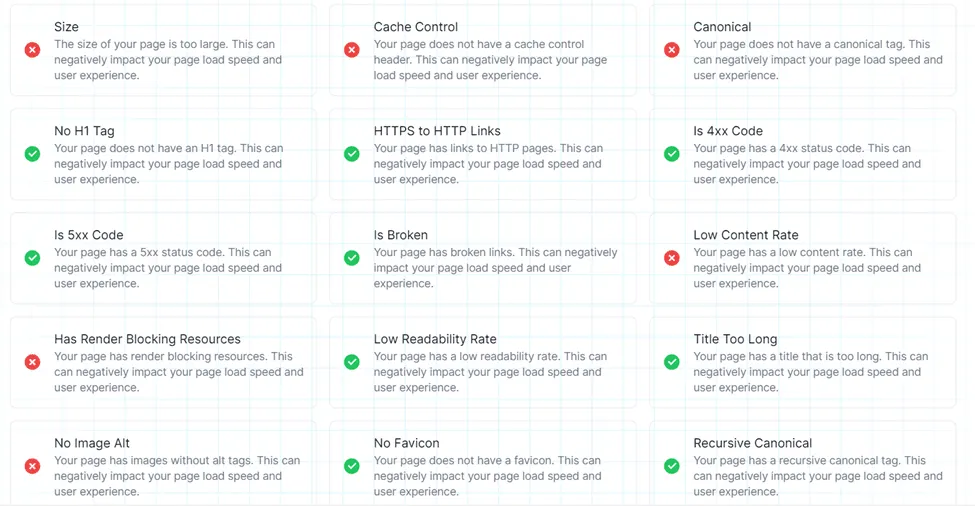 Source: SEO mator
Source: SEO mator
Although the website obtained high scores on all SEO aspects, you can immediately see SEO items that could be improved.
Tackling things like missing canonical tags, render-blocking resources, and low content rate can significantly improve:
- Page loading speed
- User experience
Let’s assume you have the same issues.
If your website were to load faster, you would have fewer visitors bouncing back to Google. And if the user experience were better, you would have longer and more in-depth website visits.
These two factors alone would signal to Google that your website is relevant, which means it would rank it higher.
Insider tip: Paid tools reveal other insights into your SEO strategy, like lost keyword positions.
SERP rank tracker AccuRanker can help you quickly see the keywords for which your website has moved up or down, comparing it to its competitors.

Source: Accuranker
1.2. Your Audience
Researching your audience tells you useful things for B2B SEO, such as:
- The language they use
- The matters they are interested in
- How they conduct research
- What they value most in a product
- Their most poignant needs
All these details can be used to:
- Zero in on seed keywords: You can use these for more in-depth keyword and topic research during step 3.
- Find the most convincing type of B2B content for your audience: For example, your audience may want industry studies or white papers. Another B2B company’s target audience may prefer lengthy how-to guides.
- Prioritize the right pages: If your product/service has a high learning curve, you may prioritize blog pages. If your high asking price is the main downside, you may need to focus on compelling product pages with keyword-rich customer testimonials.

Source: Semrush Blog
Where can you find useful information about your B2B target audience?
Check:
- Insights from your sales department
- Customer reviews
- Chatbot conversations
- Phone calls
- Email exchanges
- Surveys
- Social media activity
1.3. Your Competition
Running your direct and indirect competitors through an SEO tool is essential for B2B companies.
In B2B, loyalties are fickle.
You’re not just attracting new traffic to your website; you want to keep your existing customers for as long as possible.
Generating new leads is 4-5x as costly as keeping existing ones. But, B2B customers, rational decision-makers in their companies, conduct regular market research to find better products.
So it’s essential to see what your competition is doing in terms of:
- Keyword opportunities
- Content assets
- Backlinks
This competitor analysis will help you find keyword opportunities for your website.
Pro tip: You can also use an SEO tool to reveal your competitors’ most linked-to resources and the creators citing them. Chances are you can:
- Build better content assets on similar topics.
- Reach out to the same niche creators for a backlink.
AccuRanker is another valuable tool here.
For example, it analyzes your share of voice, comparing your website with the competitors to see if you’re losing or winning on high-traffic keywords:

Source: Accuranker
2. Build a Customer Value Proposition (CVP)
Unlike a B2C buyer persona, the customer value profile focuses on B2B customers’ common needs.
Here’s why you should use this concept:
When building a buyer persona for B2C, marketers give it a name, age, a specific number of kids, and a few hobbies.
However, your B2B buyers come from very distinct segments in terms of demographics and psychographics.
They have different ages, preoccupations, family lives, and so on. But they all share a common need.
That need should be one that your product can solve.
Consequently, the customer value proposition (CVP) represents a statement explaining what your product/service can do for your target audience.
B2B firm Unbounce offers a neat example:
Source: Unbounce
The website states that Unbounce can help marketers build landing pages fast, with just two intuitive builders and smart features. The promise is clear: companies can grow their businesses quickly using Unbounce.
Following the same example, you can build your CVP like this:
- Start with a big CTA that addresses your customers’ main need: In this case, “Create irresistible buyer journeys with landing pages.”
- Explain what makes you stand apart: For Unbounce, it was “two easy-to-use builders and smart features that help you optimize fast.”
- End with another CTA: Unbounce’s is “Start building for free,” which is very compelling because their customers can try their tool without committing to a paid service.
Pro tip: Notice that the Unbounce CVP is skillfully keyword-optimized. It would be best if you did that, too, and you’ll learn how from the section below.
3. Do Keyword Research
If you did step one correctly, you already have a few seed keywords and keyword ideas from:
- Competitor gap analysis
- Audience research
When doing keyword research:
- Understand the positions for your website ranks highest.
- Analyze your competitors to see if there is any overlap.
- Look at the keywords your competitors rank for to find missed opportunities.
For example, you can realize that while you have more organic traffic, your top competitors have higher organic traffic value.
You can then take one of your competitors and analyze their ranking keywords.
You can now take these seed keywords and run them through:
- Quora
- An SEO tool
The purpose is to find long-tail keywords that your audience is looking for.
Remember: You want to match your customers’ search intent to signal to Google that your products are relevant for a specific target audience.
That way, your SEO ranking increases, and you will gain more organic exposure.
That’s important because, theoretically, the first-ranking website gets 71% of traffic, while the second gets just 6%.
Let’s say you have a B2B communications company, and your data suggests that your prospects are interested in wireless communication, such as tempo wireless.
A quick Google search on “tempo wireless” reveals topics that interest the audience:
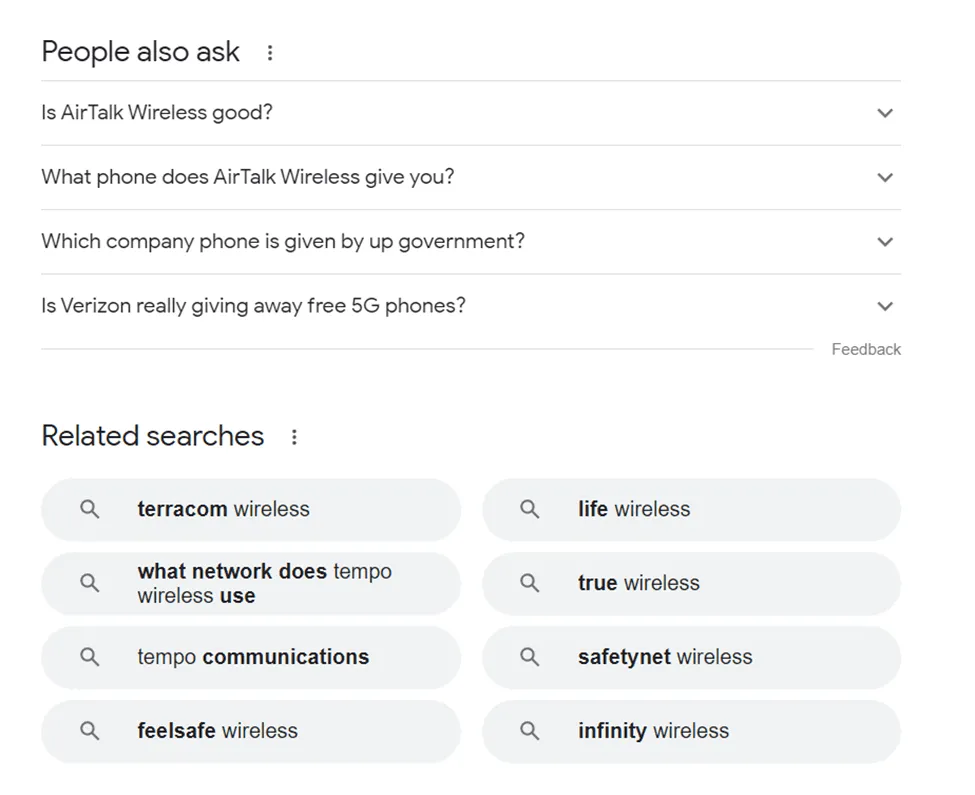
Source: Google
You can use these ideas to make a listicle comparing different products.
Pro tip: You may not want to write much about a specific product.
In this case, go back to the basics of keyword research:
- Take another seed keyword that has frequently appeared during sales conversations.
- Run it through an SEO tool to review its potential. Analyze metrics like keyword difficulty, Search volume, traffic, and cost per click.
- Then, look at keyword ideas and questions that the SEO tool offers.
- Run a Google search to get more ideas. You can also search for this term on other engines or websites, like Quora, Wikipedia, or Reddit.
- Decide on ten topics you want to write about and move on to the next section.
Insider tip: Once you have your list of keywords, add it to AccuRanker as a CSV file. Then, integrate AccuRanker with Google Search Console and Google Analytics.
Instead of checking each keyword’s stats, this SERP rank tracker gives you a better idea of how your keywords rank.
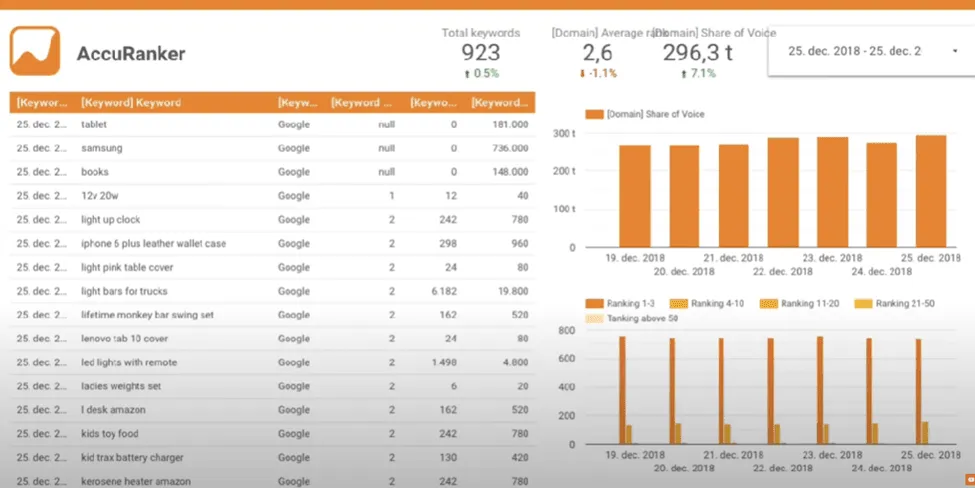
Source: Accuranker
4. Create Linkable Content for Your Sales Funnel
At this point, you need to focus on two things:
- Creating content that appeals to your B2B buyers according to the stage of the sales funnel they’re in.
- Making sure that content is appealing to potential link partners as well.
4.1. Build Content for Your Sales Funnel
The first step is building your sales funnel.
- Understand what type of content your customers want to read at each stage of that content funnel. You already found that in section 1.
Take your list of keywords and arrange them according to sales funnel stages.
- Top of the funnel (awareness and discovery): You need informational keywords that focus on answering your prospects’ questions.
- Middle of the funnel (evaluation): Use navigational keywords pointing your prospects to your website or web pages. You should also use commercial keywords your potential clients use when evaluating specific services.
- Bottom of the funnel (purchase): Transactional keywords like “buy tool X” are best for this stage.
Side note: Packing your SEO content with transactional keywords for the ready-to-purchase audience may be tempting, but it’s not a winning tactic.
A successful B2B SEO strategy starts with educating your audience.
You want to create a relationship with them in the long term, proving your expertise and authority. You can get more loyal customers consistently if they view:
- You: As a source of valuable information
- Your tool: As indispensable in reaching their business goals
How can you write solid content for your B2B prospects while outranking your competition?
Let’s assume your main competitor is Datadog.
The company has multiple articles that teach its audience how to use this software: Source: DatadogHQDatadog also has informative pieces for the top of the sales funnel, like this one:
Source: DatadogHQDatadog also has informative pieces for the top of the sales funnel, like this one:
 Source: DatadogHQ
Source: DatadogHQBut since “AWS Lambda” is a short-tail keyword, it probably has a high difficulty.
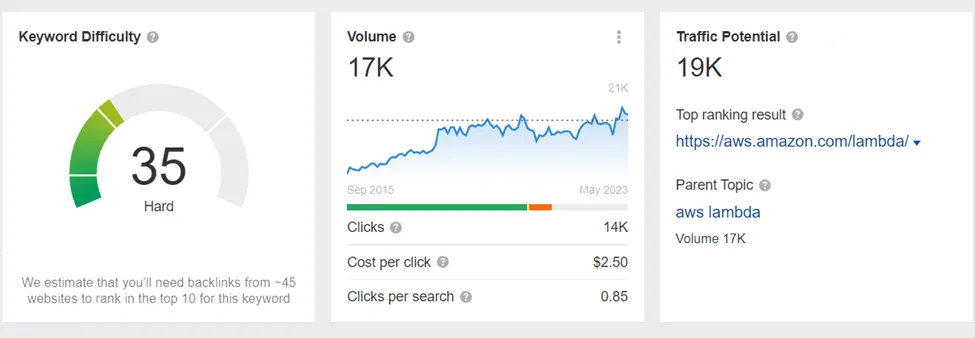 Source: AhrefsLuckily, Google suggests similar keyword ideas, and you can find a less difficult, long-tail keyword:
Source: AhrefsLuckily, Google suggests similar keyword ideas, and you can find a less difficult, long-tail keyword:
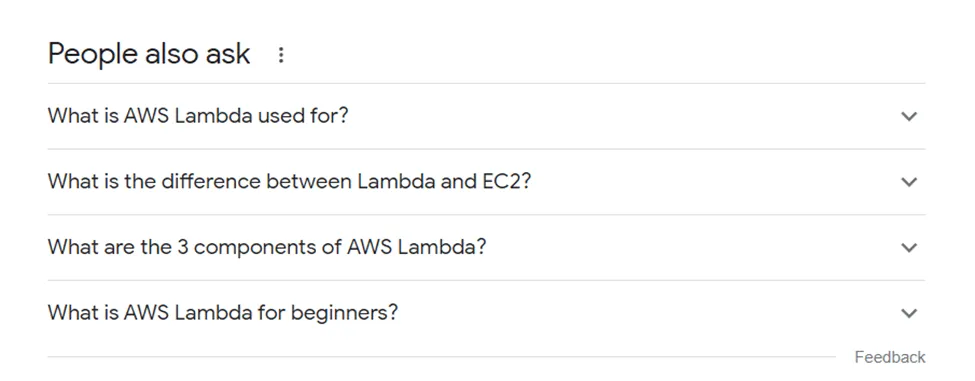 Source: Google Search
Source: Google SearchLet’s say you decide to use the term “What is AWS Lambda.”
The next step is to look at articles that rank high for this keyword, either from your SEO tool’s suggestions or Google’s. Source: Google SearchNext, open the first article and see how you can make it better:
Source: Google SearchNext, open the first article and see how you can make it better:
 Source:Amazon Docs
Source:Amazon DocsYou can easily improve Amazon’s content by adding images, infographics, and examples.
Insider tip: Write content based on specific insights from your sales department.
For example, your sales department may reveal that most of your B2B prospects ask how your products stack up against a specific competitor.
You can then ask your content marketing department to write an in-depth review comparing those products.
4.2. Build Linkable Content
Linkable content is picked up by potential link partners organically.
That means you must:
First, find keyword opportunities by analyzing your link partners’ search intent.
You can:
- Look at what they typically post.
- Run their websites through an SEO tool like AccuRanker or Ahrefs.
- Use a tool like BuzzSumo to discover industry trends.
- Analyze your competitors’ most linked-to content assets.
For example, SEMrush publishes the yearly “State of Search.” This asset is specifically created for:
- SEMrush’s audience, meaning marketers and SEO people who want to understand customer behaviors better.
- SEMrush’s potential link partners, which can be anyone from marketing news websites to niche creators. But this report is also cited by marketing agencies and businesses who wish to prove specific arguments to their clients.
 Source: Semrush Blog
Source: Semrush BlogRemember: You don’t necessarily need to build in-depth industry reports.
Find statistics in your niche that interest your audience and potential link partners, and write a blog post about them.
Here’s another neat example you can adapt to your industry: Source: Orbit Media
Source: Orbit MediaReplace “content strategies” with your niche’s focus point and replicate it at a smaller or larger scale. For example, instead of 1016 bloggers, you can quote just 5-10 specialists in your niche.
5. Optimize Your Internal Link Structure
Build your internal link structure in a coherent, cohesive way.
Most B2B websites neglect this part, though a solid internal link structure helps Google index your website and web pages better.
Besides, your website visitors can now spend more time researching additional materials.
This increase in visit depth and length signals to Google that your website is a valuable resource so that it will rank you higher.
So, link back to:
- Past content
- Money pages
Insider tip: Link to your newest articles from past articles. Adding these links to older content is a good tactic to get more traffic to your latest pieces.
6. Optimize Your Money Pages
To optimize your money pages, you must first identify the issues you want to fix.
Pro tip: Use Google Analytics to understand each page’s traffic and conversion rate.
Here’s how you can optimize your money pages:
- Use specific long-tail keywords with high transactional intent.
- Communicate your CVP clearly.
- Add clear CTAs.
- Include customer testimonials and links to case studies.
- Feature compelling FAQs, which are treasure troves of keywords.
- Add images and videos to be more persuasive.
- Conduct A/B testing to optimize your conversion rate.
 Source: DatadogHQAgain, you can use AccuRanker to look at what your competitors are doing on their landing pages, analyzing your share of voice.
Source: DatadogHQAgain, you can use AccuRanker to look at what your competitors are doing on their landing pages, analyzing your share of voice.
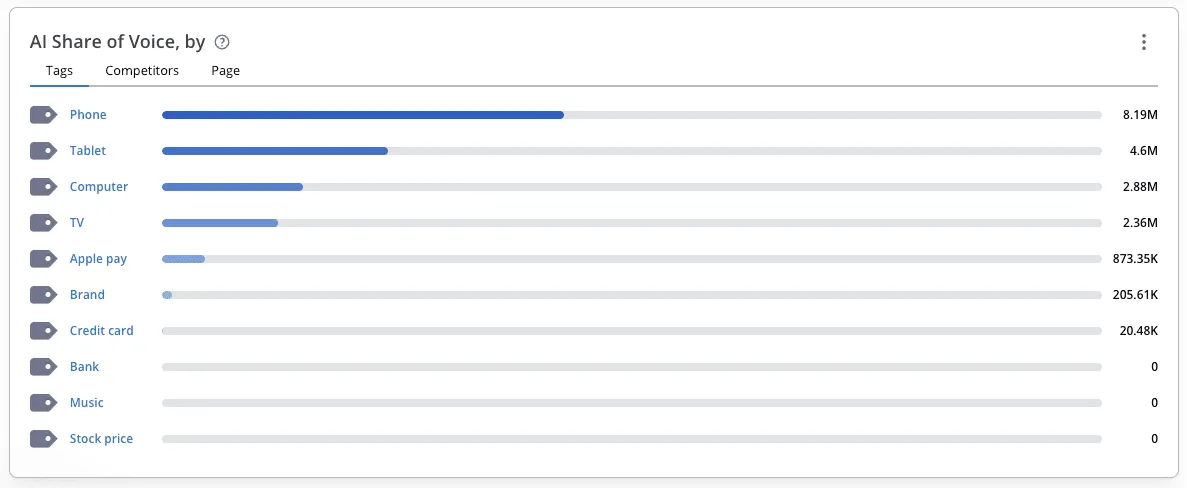 Source: Accuranker
Source: AccurankerYou can then use this information to reverse-engineer their landing page content strategies or find their weaknesses.
7. Build Backlinks
Building backlinks to your website signals to Google that you have a highly authoritative, relevant website.
The Google algorithm ranks relevant websites higher because they’re more useful.
If you do it correctly, this tactic increases your organic traffic consistently in the long run.
Pro tip: Reputable B2B link building agencies recommend dividing your strategy into short-term and long-term goals.
In the short term, you can find link opportunities such as:
- Unlinked brand mentions: A website has mentioned your product/company but hasn’t linked to it. Use Google or an SEO tool to reveal those unlinked mentions.
- Broken links: A potential link partner has linked to your competitors, but that link is now broken.
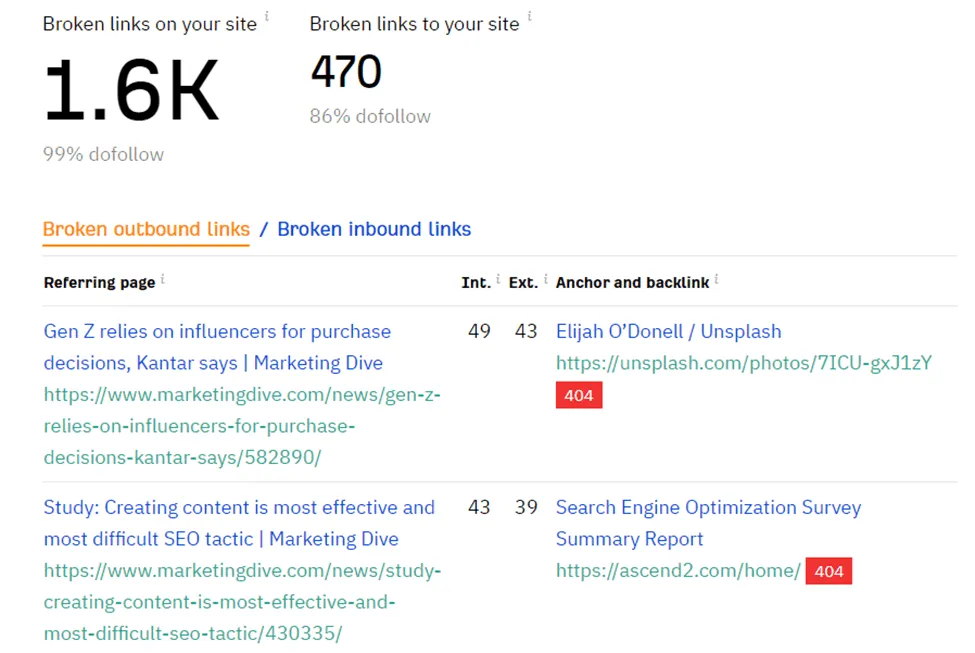 Source: Ahrefs
Source: AhrefsYou can send an outreach email if you already have such a content asset on your website.
In the long run, you can consider tactics like:
- HARO (Help A Reporter Out): Register on this website and respond to queries from journalists on your niche. Your insights can be picked up and used in their articles, thus gaining you valuable editorial links.
- Guest posting: Writing guest articles highlights your expertise in outlets that your audience and other creators in your niche are reading.
- Relationship link-building: This means building professional relationships with potential link partners on other channels, such as social media. When you publish a piece of content, your existing audience of creators is likelier to mention it.
- Roundup posts: Expert roundups are especially interesting for your audience because they present multiple experts’ opinions on specific matters. Besides, you can get numerous links from the authoritative sources you’re mentioning.
 Source: Mariopeshev
Source: MariopeshevPro tips:
- Analyze your competitors’ most linked-to content assets to find potential partners.
- Avoid link farms, link purchases, Private Blog Networks (PBNs), and other gray or black-hat tactics.
- Check that these websites have good domain ratings, authority, and genuine traffic. Even a free traffic checker can show you these stats:
 Source: Ahrefs
Source: AhrefsOnce you have a list of potential link partners and a link-building strategy, conduct outreach.
Remember to:
- Write personalized emails.
- Hook your creators by mentioning one of their favorite ideas or topics.
- Offer a unique advantage if they link to your content, such as a unique perspective for their audience.
- Follow up a maximum of two times if they have not replied.
Wrapping Up
If you take one thing from this guide, let it be that a successful B2B SEO strategy relies on data and solid planning.
In the B2B space, you must educate your audience, build relationships, and become relevant for influential niche creators.
But it’s equally important to fix your technical and on-page SEO issues to ensure search engines can index it.
If you follow the steps above, you will certainly dominate SERPs in your niche.
Related blog posts

5 LLM Visibility Metrics You Should Track in 2026
SEO is now both about ranking in search engines and being visible in LLMs. We give you five visibility metrics every SEO should track in 2026.
3 December 2025Is LLM Tracking Relevant for You?
LLM tracking is not just for SEOs. It is also relevant for content teams, agencies, marketing leadership, and communication teams. Learn why here.
26 November 2025
How to Find the Best Prompts to Track for AI Visibility
Do you want to start tracking prompts to optimize your AI visibility? We give you seven practical ways to identify relevant prompts to track in LLMs.
9 November 2025
